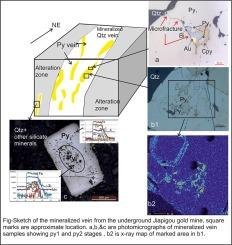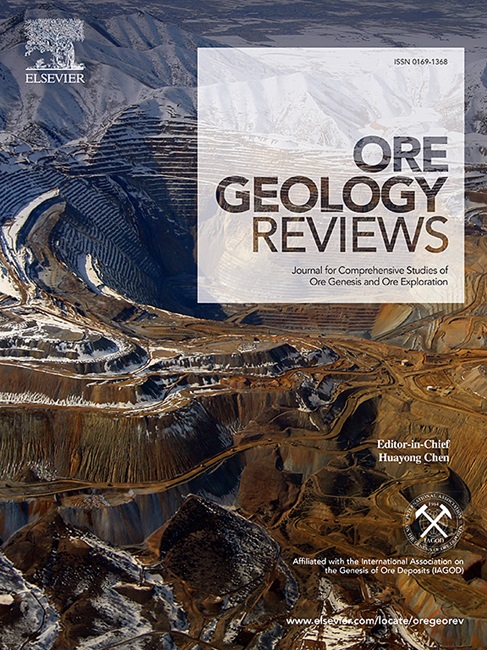华北克拉通嘉皮沟金矿床的流体包裹体和黄铁矿地球化学:对造山运动金矿床起源的影响?
IF 3.2
2区 地球科学
Q1 GEOLOGY
引用次数: 0
摘要
吉林省的贾皮沟金矿带被认为是华北克拉通(NCC)的重要产金区。该地区的金矿主要分布在矿化石英脉和蚀变带中,蚀变带的特征是硅化、黄铁矿化和磷酸盐化。石英脉中含有三代矿化石英,即 qtz1(可能是最古老的)、qtz2(稍年轻)和 qtz3(可能是最年轻的)。所有三代石英中的流体包裹体大致分为三种类型,即qtz1 & qtz2 中的 Ia 和 Ib 型流体包裹体的显微测温分析结果显示其成分为水碳酸,盐度为 1.1 至 7.8 wt% NaCl 当量,均化温度(Th)范围为 237 至 350 °C。这些与矿石有关的流体包裹体具有低到中等的盐度,并显示出二氧化碳和甲烷的混合物。另一方面,第二类流体包裹体在qtz3中占主导地位。它们的盐度在 3.2 至 12.7 wt% NaCl 当量之间,均化温度在 180 °C 至 210 °C 之间。利用电子微探针分析(EPMA)获得的黄铁矿 X 射线元素图显示,Co 和 Ni 呈不规则带状,表明黄铁矿有两代。占据核心部分的早期黄铁矿显示出较高的 Co 和 Ni,而占据边缘部分的晚期黄铁矿则显示出较低的 Co 和 Ni。黄铁矿的激光烧蚀-电感耦合等离子体质谱仪(LA-ICPMS)分析表明,黄铁矿-1 富含 Au + Ag + Se + Cu + Co + Ni,而黄铁矿-2 中这些元素的浓度较低。这里报告的铁和其他亲黄元素(即金+银+硒+铜+钴+镍)之间的正相关关系,可能是由于流体-岩石相互作用导致饱和流体,随后沿着早期形成的黄铁矿和石英内部的微裂隙沉淀下来。嘉皮沟矿床黄铁矿的原位δ34S值在+4.5至+9.6‰范围内重叠,这与流岩作用过程中输入的地壳源成矿流体一致。本文通过对黄铁矿成分的系统观察和流体包裹体的研究,对家皮沟矿床金富集的成矿过程有了新的认识。本文章由计算机程序翻译,如有差异,请以英文原文为准。

Fluid inclusion and pyrite geochemistry of the Jiapigou gold deposit, North China Craton: Implication for origin of orogenic gold deposit?
The Jiapigou auriferous belt in Jilin province has been recognized as substantial gold-producers in the North China Craton (NCC). Gold mineralization in this district mainly occurs in mineralized quartz veins and alteration zones, characterized by silicification, pyritization, and argillitization. The quartz veins contain three generations of mineralized quartz, namely, qtz1 (probably oldest), qtz2 (slightly younger), and qtz3 (probably youngest) were identified using SEM-CL. The fluid inclusions in all three generations of quartz are broadly of three types, viz., bi-phase Ia (H2O-CO2), tri-phase Ib (H2O-CO2-NaCl ± CH4), and II (H2O-NaCl).The micro-thermometric analysis of the type Ia and Ib fluid inclusion in qtz1 & qtz2 have aqueous-carbonic composition and exhibit a similar salinity of 1.1 to 7.8 wt% NaCl equivalent, whereas the homogenization temperature (Th) range varies from ∼237 to ∼350 °C. These ore-related fluid inclusions are of low to moderate salinity, and show mixture of CO2 and CH4. On the other hand, Type II fluid inclusions are dominant in qtz3. They have salinity of 3.2 to 12.7 wt% NaCl equivalent and homogenization temperature varying between 180 °C and 210 °C. These data indicate that the ore-forming fluid evolved from a CO2–H2O–NaCl ± CH4 system during the mineralization period.
The X-ray elemental maps of pyrite acquired using electron microprobe analysis (EPMA) show irregular zones of Co and Ni indicating two generations of pyrite. The early-stage pyrite which occupies core portion shows high Co and Ni, whereas the later-stage pyrite occupying rim has lower Co and Ni. The laser ablation-inductively coupled plasma-mass spectrometer (LA-ICPMS) analyses of pyrite has indicated that pyrite-1 is rich in Au + Ag + Se + Cu + Co + Ni, whereas, pyrite-2 has lower concentration of these elements. A positive correlation between Fe and other chalcophile elements reported here (i.e. Au + Ag + Se + Cu + Co + Ni), might be due to fluid-rock interaction resulting into a saturated fluid that subsequently precipitated along the microfractures within earlier-formed pyrite and quartz. The in-situ δ34S values in pyrite from Jiapigou deposits overlap in the range of +4.5 to +9.6 ‰, which is consistent with the ore-forming fluids of the crustal origin input during fluid-rock interaction. The systematic pyrite compositional observations and fluid inclusions study documented here to provide new insight into the process of ore formation for the Au enrichment in the Jiapigou deposit.
求助全文
通过发布文献求助,成功后即可免费获取论文全文。
去求助
来源期刊

Ore Geology Reviews
地学-地质学
CiteScore
6.50
自引率
27.30%
发文量
546
审稿时长
22.9 weeks
期刊介绍:
Ore Geology Reviews aims to familiarize all earth scientists with recent advances in a number of interconnected disciplines related to the study of, and search for, ore deposits. The reviews range from brief to longer contributions, but the journal preferentially publishes manuscripts that fill the niche between the commonly shorter journal articles and the comprehensive book coverages, and thus has a special appeal to many authors and readers.
 求助内容:
求助内容: 应助结果提醒方式:
应助结果提醒方式:


